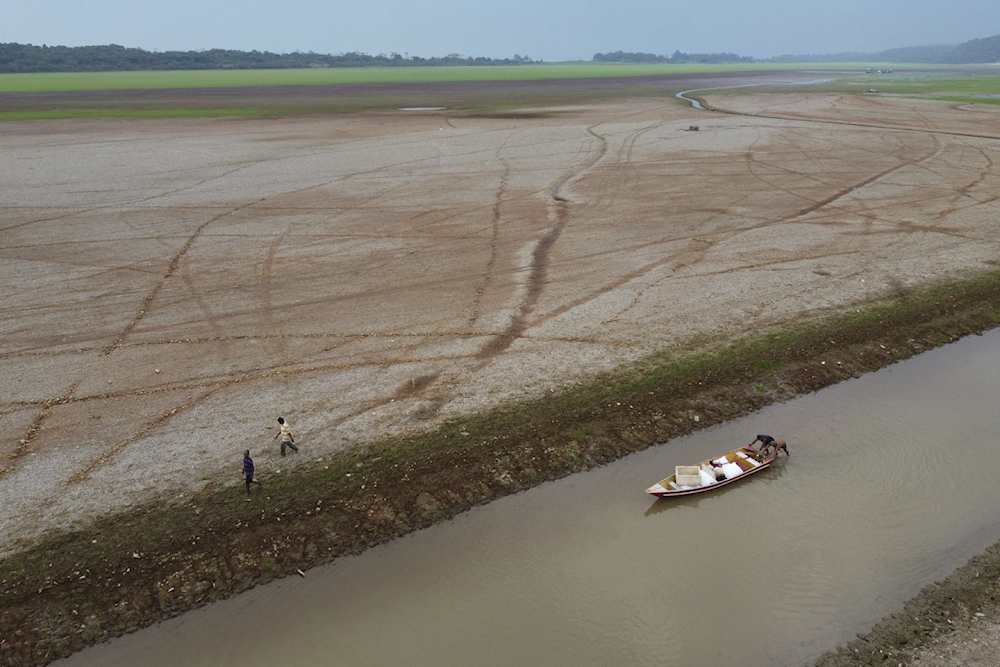Record forest loss in 2024 driven by wildfires, data shows
Fires drove the worst forest loss ever recorded in 2024, with tropical ecosystems burning at an alarming rate, researchers warn.
-

Fisherman push a boat in the Aleixo Lake amid a drought in Manaus, Amazonas state, Brazil, September 24, 2024 (AP/Edmar Barros)
The world experienced the highest level of forest destruction ever recorded in 2024, driven by a sharp rise in climate-fueled wildfires, according to new global data that scientists described as "frightening." From the Amazon rainforest to the Siberian taiga, forests vanished at a record pace, with fire surpassing agriculture and logging for the first time as the leading driver of tropical forest loss.
The findings, based on satellite analysis by the University of Maryland and hosted by Global Forest Watch, show that forest cover equivalent to the size of Italy was lost last year due to farming, logging, mining, and increasingly, fires intensified by rising global temperatures.
In tropical zones, which host the most carbon-rich and biodiverse ecosystems on Earth, the shift is especially alarming. Fire is not a natural part of these moist, humid biomes, yet it now leads the charge in their destruction. Boreal forests in Canada and Siberia also continued to burn, further contributing to global loss.
Professor Matt Hansen, co-director of the university’s Global Land Analysis and Discovery (GLAD) Lab and lead author of the study, called the figures “frightening,” warning that humanity is entering a perilous phase of ecological degradation.
Fires overtake farming as the top driver of tropical forest loss
For the first time since records began, fire surpassed all other causes of tropical deforestation. The Amazon, already under threat from extractive industries and agricultural expansion, saw fire ravage its already stressed ecosystems.
In Brazil, primary rainforest loss reached a staggering 25,000 square kilometers, 42% of all tropical forest loss globally. This exceeds any destruction recorded even during the administration of former far-right president Jair Bolsonaro. The numbers diverge from Brazil's official deforestation figures, which notably exclude fire-related loss.
Neighboring Bolivia ranked second in overall forest loss, driven by fire, extreme drought, and government policies promoting agricultural expansion for soy, sugar cane, and cattle. Since 2020, Bolivia’s primary forest loss has surged nearly fivefold, reaching more than 14,000 square kilometers.
Bolivia saw its 3rd year in a row of record-breaking forest loss in 2023, losing 27% more forest than the year before.
— Global Forest Watch (@globalforests) April 8, 2024
Fires 🔥 and agricultural expansion are major drivers, according to our new #TreeCoverLoss analysis with @WorldResources.
Read more: https://t.co/Dp70SH9mef pic.twitter.com/hjHLic72HH
Congo basin sees highest recorded rainforest losses
In Central Africa, forest destruction also surged. Both the Democratic Republic of the Congo (DRC) and Congo-Brazzaville witnessed unprecedented loss of pristine rainforest. These nations share the Congo basin, the world’s second-largest rainforest after the Amazon. The data show that efforts to preserve this vital carbon sink are falling far short.
At the COP26 climate summit in Glasgow, over 140 world leaders pledged to halt deforestation by 2030. But just four years later, the trajectory has worsened. According to researchers, to meet the 2030 pledge, forest loss would need to decline by at least 20% annually starting from 2024 levels—an increasingly unlikely outcome.
“This signal is particularly frightening,” said Hansen. “Rising global temperatures are making forests hotter and drier, and as a result, more likely to burn. Given human ignition, even remote rainforests can burn uncontrolled.”
Elizabeth Goldman, co-director of Global Forest Watch, described the findings as a “global red alert,” calling for immediate action. “This is a collective call to action for every country, every business and every person who cares about a livable planet. Our economies, our communities, our health, none of it can survive without forests,” she said.
Professor Peter Potapov, also of the GLAD Lab, warned of the long-term consequences of failing to act. “2024 was the worst year on record for fire-driven forest loss, breaking the record set just last year. If this trend continues, it could permanently transform critical natural areas and unleash large amounts of carbon, intensifying climate change and fueling even more extreme fires.”
He described the situation as a dangerous feedback loop: more warming leads to more fires, which release more carbon, which in turn accelerates the warming.
Amid the grim data, there were glimmers of progress. Primary forest loss in Indonesia and Malaysia remained relatively low. For the first time, Malaysia dropped out of the top 10 countries for total forest loss, a signal that concerted policy efforts, enforcement, and international pressure may be starting to bear fruit.

 4 Min Read
4 Min Read








